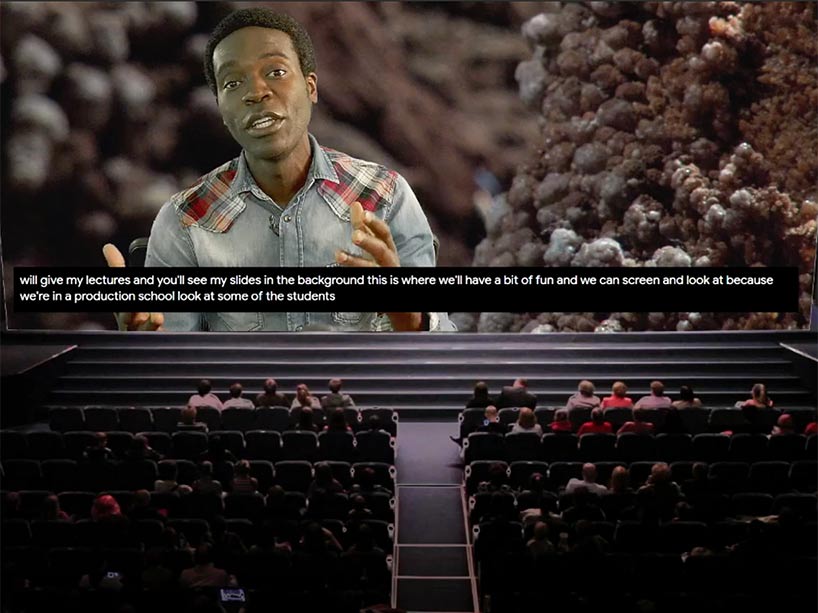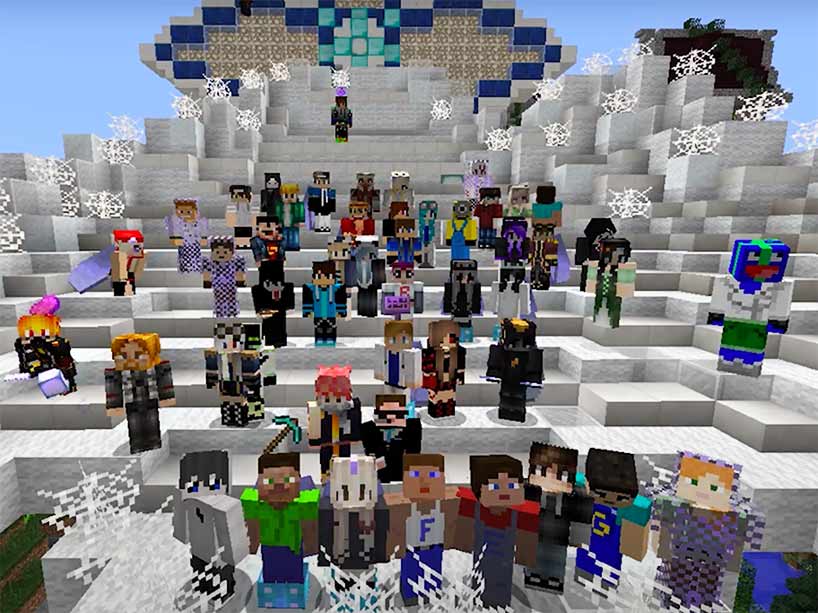How three Ryerson profs are changing the game of online learning

Professor Kristopher Alexander is projected on screen in a computer-simulated lecture hall he created for his virtual classes. Photo credit: Kristopher Alexander.
Imagine playing a video game in front of all of your classmates as part of your university degree. Or, taking a Cineplex-style quiz for class, or creating a personal avatar and hanging out with your classmates in a virtual student lounge.
Sound like a fun way to learn? In the new era of remote learning, these are some of the innovative ways Ryerson professors at FCAD (Faculty of Communication and Design) are teaching this fall.
“With remote teaching, we're seeing that having lengthy lectures or drawn out discussions on video chat can be quite draining, and it's difficult to keep people tuned in,” said Journalism professor Adrian Ma.
Instead, he says breaking out certain concepts and aspects of lessons and applying them in the digital space can help make them more “digestible and interactive”.
“The more online content we can introduce that emphasizes activity, immediate feedback and even just a change of pace, the better we can help meet students' different learning preferences and keep interest levels up,” he continued.
RTA School of Media professors Kristopher Alexander and Alexandra Bal agree. They, too, are applying interactive tools and a creative approach to teaching in the digital space.
Below, learn more about how these three profs are thinking outside the box to engage and inspire this fall.
Professor Kris Alexander
Check out Prof. Kris Alexander teaching his video game design course. This was the second class of the semester, live streamed on September 21, 2020. (YouTube)
Video game design professor Kristopher Alexander says that for decades, students have been learning from sites like YouTube, and Twitch, and interacting directly online with their favourite streamers and online celebrities.
“This is their world. As professors, we need to meet this standard so we can reach them,” he said.
Learning through play
What better way to learn about video games than by playing them? In Alexander’s classes, he cues up video games on his screen and gives students the chance to take control remotely, using the Steam video game platform for PC.
“When the students see the theory we’re learning in the games we play, live and in real-time, it tends to stick a bit more easily” he said.
For example, he says, when teaching about “tunnelling”, a persuasive technology in which the user is subtly guided down a particular path, Alexander shows the class how it works through a student’s game play.
Classes mimic what students consume
Alexander also wants his classes to look and feel like the YouTube videos, podcasts, Twitch streams, shows and forums that his students engage with every day.
His online lectures include Discord, and real-time chat boxes that appear on-screen, so students can converse and ask questions in real-time.
He also uses digital effects in his lecture that are similar to the effects used in video games, such as a “wipe” or scene transitions to signal one part of the lecture to another.
His lectures also feature subtitles in real-time, thanks to Google Slides.
“That way, both students and I have the ability to look, listen, and read at the same time - core components of my educational research,” he said, adding that this feature also makes his classes accessible.
Students can also sign up to be randomly picked to answer questions and play games in the class.
“When they do this, the suspense for answering questions is incredible,” Alexander said.
Professor Alexandra Bal

Students in Prof. Alex Bal’s classes will create avatars and “hang out” in a virtual student lounge using Minecraft. Photo credit: Alex Bal.
New media and online education expert Alexandra Bal says one of the outcomes of the pandemic could actually be an improvement in education.
“Students are more than ready to learn online,” she said. “The question is, how are professors going to meet them there?”
Bal says teaching in the virtual world will create a shift away from a passive learning model to a more active one, “which is a really powerful way to engage the student,” she said.
Virtual student lounge
One of the new techniques Bal is using this year to promote interactivity in the online space is a virtual student lounge.
“It’s important students have a place to connect with each other, especially this year. So why not do it virtually?” she said, explaining that students will be able to create avatars and “hang out” with each other’s avatars in this virtual space.
It will all be done using Minecraft, a popular video game in which players create and break apart various kinds of blocks in three-dimensional worlds. Bal’s students will use the platform to socialize, build art and learn about creative processes.
“As soon as we use one of their platforms in class - they light up,” she said, adding that she also uses Discord, where students can chat, build communities and socialize.
Showing more than the virtual world
Another strategy for Bal doesn’t actually involve the virtual space - but rather, letting students see into hers.
She’s hung a large mirror up behind her workspace, which is visible to her students, and reflects a large window showing trees in the countryside. “This way, students can watch as the leaves change colour.”
She’ll also wear flashy, colourful pants to show her personality, and she’ll encourage students to do the same.
“I want them to see our virtual interactions as more than just information sharing. Watching seasons change through my windows, and me wearing crazy pants, will help me appear as a human to my students, and someone who is isolated just like them, but who is making the best of the situation. Humour is always super important, but this year even more,” she said.
Professor Adrian Ma

In a newsroom simulation video game, professor Adrian Ma’s journalism students will be put to the test by playing the role of the managing editor in high-stress scenarios. Photo credit: Adrian Ma.
Like Alexander and Bal, digital news expert Adrian Ma sees the virtual semester as an opportunity to create new ways of teaching and engaging with students.
For example, students may want to grab the popcorn for knowledge quizzes this year. This year, Ma will be designing tests similar to the way Cineplex theatres produce interactive “Timeplay” games before a movie starts.
This means that as students are being tested on newsroom practices, there will be real-time competition, which helps to gamify the learning activity.
“I’ve found the program Kahoot! (external link) useful for this, as it allows you to create multimedia-rich live quiz games in just minutes,” Ma said.
Students can participate using their phones or computers and get real-time scoring and leaderboard updates throughout the game. In the past, Ma has offered small prizes to winners to add to the fun.
Newsroom-simulation video games
While Prof. Ma readily admits he’s not a “gamer” - his video game experience peaked with Nintendo 64 in 1997, he jokes - he’s proving that you don’t need to be one to teach in this space.
“For teachers like me, with no experience using game engines like Unity (external link) , there are still relatively easy ways to put together fun little games using a combination of accessible e-Learning tools,” he said.
Ma has been creating animated video segments with the platform Vyond (external link) and then adding interactive quiz elements through Articulate’s Storyline 360 (external link) software.
In his game, the student plays the role of the managing editor in a fictional newsroom, and needs to address various editorial situations.
Different decisions will lead to different outcomes for the newsroom, which Ma says, “will help illustrate the potential real-life consequences that we're trying to prepare them for.”
360/VR video field trips
Think field trips are out of the question in the era of Covid-19? Think again.
Students in Professor Ma’s classes will be able to go on virtual field trips instead.
Using a 360 camera, Ma says he can capture an omnidirectional video of a space or place relevant to the topic he’s teaching about.
For example, in his course, “Building the Brand”, students study the different ways clothing companies express their brand identities in their physical stores through their use of background music, visuals and store layout.
Using programs like ThingLink (external link) or Adobe Captivate (external link) , Ma can then add information hotspots or interactive annotations to the 360 video.
“By posing questions along the way or pointing out specific details I think are important, I can develop more of a guided and purposeful experience for my students,” Ma said.
Related